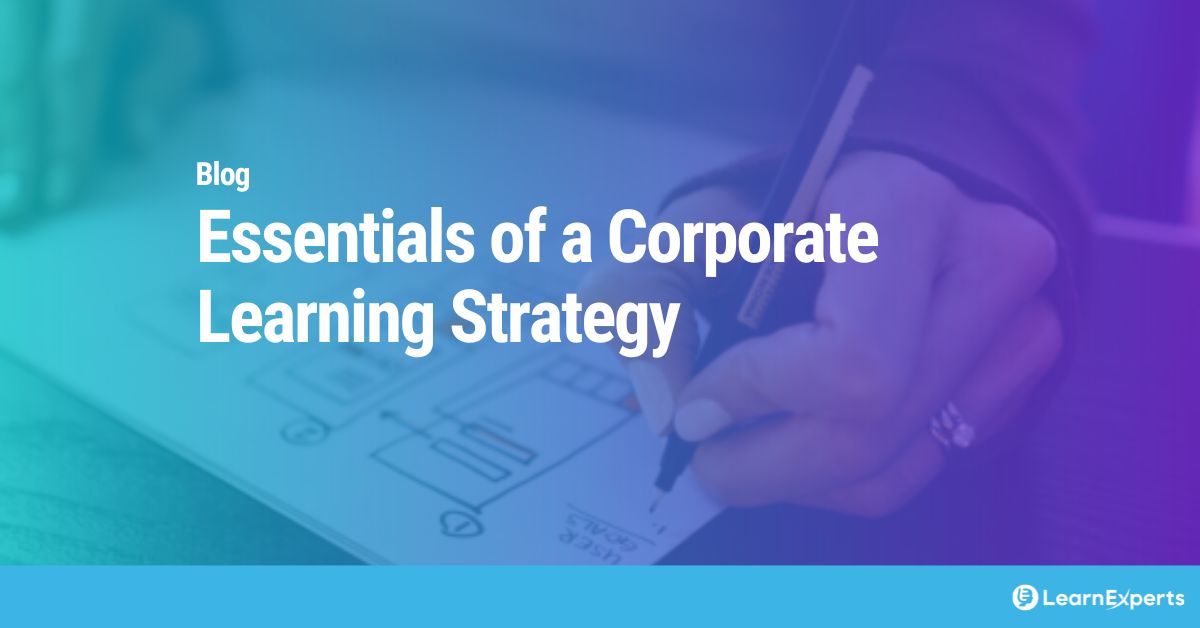How companies build a corporate learning strategy is changing.
Conventional instructor-led lectures, extended workshops spanning multiple days, and collections of unfiltered, self-paced online courses covering a wide array of subjects, are being replaced by data-driven learning programs that emphasize the development of specific skills and competencies among employees.
To keep pace with changes, learning leaders need to take a fresh approach during their strategy and planning phase and in this blog we provide some ideas on how corporations can evolve their learning and development (L&D) strategy to accommodate a changing workplace.
Key takeaways
Align learning with business goals – A corporate learning strategy should directly support organizational objectives—whether it’s talent retention, skill-building, or digital transformation—and be tied to outcomes at both company and individual levels.
Define clear objectives and target audiences – Establish precise learning goals (e.g., leadership readiness, partner enablement) and tailor them to specific learner groups—new hires, remote staff, partners—based on their roles, needs, and environments.
Map out competencies and a learning roadmap – Identify skill gaps, outline proficiency milestones, and create structured learning paths that help employees progress from current to desired competency levels—or prepare for future roles.
Use diverse delivery methods – Mix formats—eLearning, microlearning, workshops, mentorship, on-the-job training—to meet various learning styles and contexts, ensuring training is engaging and effective.
Invest in tools, resources, and support – Allocate budget and technology for content creation, delivery, and management. Ensure support systems are in place—including HR, IT, managers, and mentors—to reinforce learning and build culture.
Measure, iterate, and improve – Track effectiveness through KPIs (e.g., completion rates, skill gains, business impact). Collect learner feedback and continually refine the strategy to ensure ongoing alignment and relevance.
What is a corporate learning strategy
A corporate learning strategy is a comprehensive plan that outlines how an organization intends to develop the skills, knowledge, and capabilities of its employees. A well-designed and defined corporate learning strategy not only helps the company to achieve its business goals and objectives, it also aligns learning initiatives with the company’s overall mission, values, and long-term vision.
The key elements included in a corporate learning strategy include
- Specific objectives for the learning strategy
- Target audience for each learning initiative
- Skills gaps, areas for improvement, and learning priorities for different employee groups
- Mix of learning methods, such as eLearning, workshops, on-the-job training, and mentoring
- How learning content will be created, curated, and updated (i.e. in-house, outsourced, or third-party sources)
- Required technology tools and platforms to deliver, manage, and track learning initiatives
- Key performance indicators (KPIs) to measure the effectiveness of learning initiatives
- How feedback from learners will be collected to improve the quality and relevance of learning
- Budget and resources for building learning program
- Commitment and support from senior leadership.
How to build a learning strategy
Building a corporate learning strategy
Since an organization’s learning strategy will vary by the company, industry, and scope, it is difficult to create a universal strategy that applies to all. However, there are some critical elements that should be considered in every strategy.
Define learning strategy objectives – Consider defining overall learning objectives for the company and how it aligns with the business goals. The learning strategy should also include goals at the employee level, and outcomes specific to a role, department, or function. Objectives to consider include attracting and retaining talent, motivating, and engaging employees, building people’s skills, training sales and partners, reducing customer churn, building a company’s brand and creating a learning culture.
Target audience – When considering who the learning strategy is for, think about key players in your organization and how their contributions affect the company’s business goals. This includes new hires, existing employees, partner organizations and customers. For each of the above, consider the individual’s or business’:
- Career needs, career path and interests
- Location – remotely, hybrid or in-office
- Access to technology, tools
- Learning roadmap and learning preferences
- Success metrics
- Roles and jobs tasks
Build learning objectives and learning roadmap – Define the learning tasks and objectives for each of your learners, how they demonstrate proficiency for each task (performance milestones), the roadmap to progress through each task and developmental timelines. If the learning goal is to train employees and help them grow into their next role, define how they can begin preparations for advancement or movement to another role. Look at the current state of their skills and map what it will take for them to get to the next level.
If you are looking to train sales and partners where the goal is to increase the number and size of deals, consider including training that include both soft and hard skills like selling strategies, product knowledge training, buyer personas training, competitive analysis, sales negotiations and deal closing.
Usually, customer training focuses around product knowledge but also consider including training that helps your client do their jobs better. For example, if you sell marketing software, don’t just create training that helps your clients to use your software. Consider adding training that teaches your clients the latest marketing trends and how to perform day-to-day marketing activities (that may include your software). This helps to increase brand recognition and brand loyalty.
Choose learning delivery – Define how the learning will be delivered. Training modes to consider include blended learning, microlearning, instructor led training (ILT), virtual instructor-led training (VILT), eLearning and online courses, mobile learning (mLearning), informal learning like chat groups, experiential learning and job aids and tools. Also, consider what learning content is going to be delivered en masse, or individually, who will be delivering learning content and how you measure effectiveness.
Determine resource allocation – Evaluate what resources are going to be available for the learning strategy, education budgets and timelines. Often companies are focused on who is going to deliver the content and what technology is required and they underestimate the resources required to create the learning content. (Tip: Check our blog on Rapid Content Development to learn how Blue Prism accelerated their learning content development process).
Plan for learning support – For employees, consider outlining how human resources (HR), IT, managers and peers are to participate and support the learning process. Don’t forget to include mentorship and peer-to-peer learning as part of your learning strategy.
Include assessment for learning strategies – As part of your learning strategy, include checkpoints to ensure that the program is meeting its intended goals. Consider measuring continuously or periodically how well students are learning the content, instructors are delivering the material, online courses are working for your audience (look at metrics like completion rate) and the overall program is meeting the needs of the organization or customer
Design to scale – Often learning programs start as pilot programs and scale once they have proven to be successful. From the onset, measure the cost per learner and the impact, and use this information to build the case and strategy for deploying learning programs across the organization. When measuring impact, consider answering the following questions:
- How well does the learning strategy support the organization’s goals?
- How does the learning program help employees, customers or partners build skills and expertise to more efficient or productive, better adopt a solution or better deliver a solution on your behalf?
- How does an internal learning program affect employee retention?
A 2021 survey on the U.S. training industry found that remote training increased to 31 percent in 2021, up from 19 percent in the previous year.
Example of a learning strategy
Here is what a basic learning strategy for a healthcare company may look like
- Program objective: Enhance the clinical skills and knowledge of healthcare professionals to improve patient care, safety, and compliance with industry regulations.
- Target audience: Physicians, nurses, administrative and support staff.
- Needs assessment: Analyze gaps in clinical knowledge, recent patient incidents, compliance issues, and regulatory changes to pinpoint specific areas of improvement.
- Learning objectives: Reduce patient incidents by 25 percent. Train staff on recent state healthcare privacy regulations. Ensure all staff have completed training on [medical equipment or procedure].
- Learning delivery: eLearning for compliance modules. eLearning, mentoring and coaching for patient handling best practices. Instructor-led workshops for new medical equipment/procedure.
- Learning paths: (Outline courses and the order of the courses that each of your target audience will take to meet their learning objectives)
- Resource allocation: Corporate training team to build compliance and patient safety protocol courses. Manufacturer to provide training on medical equipment/procedures.
- Delivery: Use LMS for delivery of eTraining. Schedule workshops within first 3 months of fiscal year and follow-ups after 6 months.
- Feedback loop: Send survey at the end of each workshop. Test knowledge retention within 3 months of training delivery
Learning strategy tips
Given that today’s workforce might be different than the pre-pandemic workforce, it is worth noting some trends that should be incorporated into a learning strategy.
Pay attention to hybrid/remote workers – Given that hybrid work or completely remote is the new “normal,” the learning strategy should include ways to encourage connections and learning when learners are away from the office.
Use learning to create new communities – With online meetings becoming easier and more socially acceptable, look to incorporate peer learning and social learning strategies that encourage connections with peers in different offices and countries. This creates the opportunity to learn new ways to do things, understand cultural differences and create a more cohesive corporate culture.
Let learners set their learning schedule – L&D strategies must all include more self-paced and self-directed learning so learners can take learning when it is most convenient for them.
Opt for blended learning – Blended learning is already in use in the corporate environment. According to the survey, 43 percent of learning hours were delivered with blended learning techniques in 2021, up from 33 percent in 2020.
Adopt mobile learning – Organizations are also looking at incorporating more technology into their learning strategy. This includes allowing employees to learn on work and personal devices—including cell phones.
Allowing employees to develop their own learning paths – As a way to attract and retain talent, companies continue to enhance tools which allows employees to choose topics they are interested in and build their own learning paths (or learning journeys) to develop knowledge and skills based on their personal professional development goals and interests.
Adopting agile learning strategies – A study noted by Oracle found that 57% of respondents said that the training provided by their employers is “sometimes irrelevant, boring, or outdated”; 20% said that it “often” was, and 11% said it was irrelevant, boring, or outdated “all the time”. To keep learners engaged and motivated, evaluate processes for creating and maintaining learning content, and consider using agile strategies that include frequent iterations of training design and content.
Think about upskilling and reskilling – Make sure that your learning and development strategy includes opportunities for learners to increase their skills in their current job (upskilling) and/or learn new skills for a new job (reskilling).
Encourage continuous learning – In your learning strategy, include activities and communication that encourages individuals to undertake learning at a regular cadence.
Incorporate more technology – The pandemic has increased the availability of many new solutions that can make implementing a successful learning strategy easier. Beyond learning management systems (LMS), there are tools for learning content creation (like LEAi), gamification, adding virtual reality and more that can make learning more fun and effective.
Measure impact of learning – As an L&D leader, find ways to track engagement and how learning is increasing value to an organization. Report results regularly so there is visibility in the impact of the program and to build a view that learning programs are not cost centers.
What to consider when bringing different AI technologies into the workplace
Using LEAi in your learning strategy
Our experience at LearnExperts has been that slow course creation can hinder the success of a learning strategy. Many organizations still use a traditional process where L&D staff are interviewing subject matter experts (SMEs) and then translating their knowledge into course content using word processing tools (like Word or PowerPoint). This is a long and manual process that requires time and expertise and does not allow learners to be exposed to the latest knowledge.
To increase the speed and success of learning strategies, we decided to create LEAi to enhance training programs, increase learning efficiency, and reduce costs. Here’s how it could be part of the strategy:
- Rapid content creation and update: LEAi’s AI-powered tool can help organizations rapidly create and update training materials tailored to specific needs so content stays relevant and aligned with business objectives.
- Follows training best practices: LEAi’s content generation capabilities are designed to follow instructional design principles, ensuring that training materials support active learning, and enhance retention and understanding.
- Cost-effectiveness: Since LEAi automates much of the content development process, organizations can reduce the time and resources needed to develop training materials, thus lowering costs while maintaining high-quality learning content.
- Integration with existing systems: LEAi can be integrated with Learning Management Systems (LMS) or other platforms that businesses use to deliver training and development.
Key benefits of LEAi include:
- Use content that exists in your organization to create automatically create content that you need to build and produce your courses
- Be guided by best practices with our LearnAdvisor
- Update existing courses fast with our auto-update feature
- Repurpose content easily for different modules and courses
- Use the content to create different learning delivery modes
- One-click microlearning
- Translate content into multiple languages
- Automatically create test questions to assess how well the content was understood
With LEAi you can now create content for both online, in-person and blended training. This includes class content, presentations, webinars, videos and more – all in minutes, rather than days, weeks or months. If you are in the market for a course creation tool or would like to speak to our experts on how to build a successful corporate learning strategy, give us a shout!




